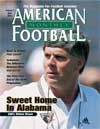AMERICAN FOOTBALL MONTHLY THE #1 RESOURCE FOR FOOTBALL COACHES
Article CategoriesAFM Magazine
|
NEVER A DOUBTOklahoma\'s rise to the top of the college football world may have surprised some people, but not head coach Bob Stoops.by: Richard Scott © More from this issue An upset? Don't call Oklahoma's national championship or its Orange Bowl victory over Florida State an upset. An upset is when a team that shouldn't win beats a team that should win, and that wasn't the case when the Sooners completed their undefeated season by beating the Seminoles 13-2. So what if Florida State was favored to win by nearly two touchdowns? So what if the Seminoles were playing for the national championship for the third time in four years? So what if the Sooners were one of the youngest teams in the Big 12, and just one year removed from a 4-8 season that ended with four defeats by a combined score of 176-28? So what if Oklahoma's glorious football tradition seemed more like a ghost than a heritage? So what if no one outside the Oklahoma football program expected the Sooners to be undefeated, let alone ....The full article can only be seen by subscribers.
|
|
|||||||
| HOME |
MAGAZINE |
SUBSCRIBE | ONLINE COLUMNISTS | COACHING VIDEOS |
Copyright 2025, AmericanFootballMonthly.com
All Rights Reserved





